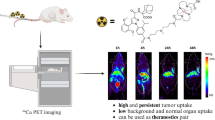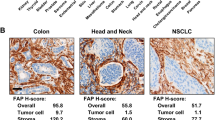Abstract
Alkylphosphocholines, and especially their main representative hexadecylphosphocholine (HPC), show high anticancer activity in methylnitrosourea(MNU)-induced autochthonous rat mammary carcinoma. The regression of MNU-induced rat mammary carcinoma during HPC treatment can be evaluated by computed tomography and sonography. This allows a noninvasive monitoring of therapy in vivo (tumor size, morphology, and blood supply). Both diagnostic modalities can show a rapid concentric decrease in tumor volume as well as the appearance of cystic, scarry, and necrotic areas in the tumor tissue as a result of HPC treatment. In addition, prior to, during and after therapy tumor perfusion can be assessed by color Doppler sonography in vivo. A more than 4-fold difference in HPC efficacy was observed when the colony growth of explanted MNU-induced mammary carcinoma cells was measured in the methylcellulose colony assay (IC50=180 νmol HPC/l) and the Hamburger Salmon colony assay (IC50=740 μmol HPC/l). IN the latter assay, growth of concomitantly seeded untransformed cells, especially of fibroblasts, is much lower than in the methylcellulose colony assay. We therefore assume that the antitumor efficacy of HPC against MNU-induced mammary carcinoma is enhanced by neighboring cells such as fibroblasts. Cell culture experiments with the three MNU-induced rat mammary carcinoma cell clones 1-C-2, 1-C-30, and 1-C-32 revealed IC50 values in the range of 50–70 μmol HPC/l. The volume of 1-C-2 cells increased up to 4-fold after 72 h of permanent exposure to 100 μmol HPC/l, a concentration that completely inhibited proliferation of tumor cell numbers without being cytotoxic. Nucleotide triphosphate levels dropped significantly after 24 h and were slowly restored in spite of continued exposure. After 72 h, they nearly reached those levels observed in plateau-phase cells. This suggests that HPC-induced growth inhibition has similarities with physiologically occurring growth arrest. Finally, replication of RNA viruses and DNA viruses was suppressed 30-fold and 7-fold, respectively, at low concentrations of HPC (12 μmol/l), which caused no or negligible growth inhibition in the virus-harboring cells, thus demonstrating specific antiviral activity of HPC. From these observations we conclude that HPC differs in many important aspects from conventional cytostatic agents and is certainly worth following-up in further investigations.
Similar content being viewed by others
Abbreviations
- HPC:
-
hexadecylphosphocholine
- MNU:
-
methylnitrosourea
- CT:
-
computed tomography
References
Angres G, Scherf, HR (1989) Different effects of cyclophosphamide in vivo and phosphamide mustard in vitro on two cell clones of chemically induced mammary carcinoma of the rat. J Can Res Clin Oncol 115:203–206
Berdel WE, Andreesen R, Munder PG (1985) Synthetic alkyl-phospholipid analogs; a new class of antitumor agents. In: Kuo JF (ed) Phospholipids and cellular regulation 2 CRC Press, Boca Raton, pp 41–73
Berger MR, Habs M, Schmähl D (1983) Non carcinogenic chemotherapy with a combination of vincristine, methrotrexate and 5-fluorouracil (VMF) in rats. Int J Cancer 32:231–236
Berger MR, Muschiol C, Schmähl D, Eibl H (1987) New cytostatics with experimentally different toxic profiles. Cancer Treat Rev 14:307–317
Berger MG, Richter H, Seelig MH, Eibl H, Schmähl D (1990) New cytostatics: more activity and less toxicity. Cancer Treat Rev 17:143–154
Berger MG, Yanapirut P, Reinhardt M, Klenner T, Scherf HR, Schmeiser HH, Eibl H (1992) Antitumor activity of alkylphosphocholines and analogues in methylnitrosourea-induced rat mammary carcinomas. Prog Exp Tumor Res 34:98–115
Delorme S, Anton HW, Knopp MV, Betsch B, Trost U, Junkermann I, von Fournier D, van Kaick G (1992) Vaskularisation des Mammakarzinoms: Quantitative und morphologische Beurteilung mittels farbkodierter Dopplersonographie. Ultraschalldiagnostik '92. Springer Verlag Heidelberg (in press)
Diomede L, Colotta F, Piovani B, Re F, Modest EJ, Salmona, M (1992) Ether lipid ET-18-OMe induces apotosis in human leukemic cells. Proc Am Assoc Cancer Res 33:417
Doppler C, Schalasta G, Amtmann E, Sauer G (1992) Binding of NF-kB to the HIV-1 LTR is not sufficient to induce HIV-1 LTR activity. AIDS Res Hum Retroviruses 8:245–252
Eibl H, Engel J (1992) Synthesis of hexadecylphosphocholine (Miltefosine). Prog Exp Tumor Res 34:1–5
Eibl H, Hilgard P, Unger C (eds) (1992) Alkylphosphocholines: New drugs in cancer therapy. Prog Exp Tumor Res 34
Freshney RI (1987) Culture of animal cells. A manual of basic technique, chapter 15. Alan R. Liss, New York, pp 197–206
Geilen CC, Haase R, Buchner K, Wieder T, Hucho F, Reutter W (1991) The phospholipid analogue, hexadecylphosphocholine inhibits protein kinase C in vitro and antagonises phorbol ester-stimulated cell proliferation. Eur J Cancer 27:1650–1653
Hilgard P, Stekar J, Voegeli R, Engel J, Schumacher W, Eibl H, Unger C, Berger MR (1988) Characterisation of antitumor activity of hexadecylphosphocholine (D 18506). Eur J Cancer Clin Oncol 24:1457–1461
Hilgard P, Harleman JH, Voegeli R, Maurer HR, Echarti C, Unger C (1989) The antineoplastic activity of hexadecylphosphocholine (HPC) is associated with tumor cell differentiation. Proc Am Assoc Cancer Res 30:580
Hochhuth CH, Veymeyer K, Eibl H, Unger C (1992) Hexadecylphosphocholine induces interferon-gamma secretion and expression of GM-CSF mRNA in human mononuclear cells. Cell Immunol 141:161–168
Kötting J, Berger MR, Unger C, Eibl H (1992) Alkylphosphocholines: influence of structural variation on biodistribution at antineoplastically active concentrations. Cancer Chemother Pharmacol 30:105–112
Maurer HR, Hilgard P (1992) Induction of tumor cell differentiation by alkylphosphocholines: a new approach for in vitro screening. Prog Exp Tumor Res 3490–97
Miller FR, McEachern D, Miller BE (1989) Growth regulation of mouse mammary tumor cells in collagen gel cultures by diffusible factors produced by normal mammary gland epithelium and stromal fibroblasts. Cancer Res 49:6091–6097
Mukaida H, Hirabayashi N, Hirai T, Iwata T, Saeki S, Toge T (1991) Significance of freshly cultured fibroblast from different tissues in promoting cancer cell growth. Int J Cancer 48:423–427
Müller-Decker K, Amtmann E, Sauer G (1987) Inhibition of the phosphorylation of the regulatory non-structural protein of vesicular stomatitis virus by an antiviral xanthate compound. Gen Virol 68:3045–3056
Munder PG, Weltzien HU, Modolell M (1976) Lysolecithin analogs: a new class of immunopotentiators In: Miescher PA (ed), VII International Symposium of Immunopathology. Schwabe, Basel, pp 411–424
Muschiol C, Berger MR, Schuler B, Scherf HR, Garzon FT, Zeller WJ, Unger C, Eibl H, Schmähl D (1987) Alkylphosphocholines: toxicity and anticancer properties. Lipids 22:930–934
Sauer G, Amtmann E, Melber K, Knapp A, Müller K, Hummel K, Scherm A (1984) DNA and RNA virus species are inhibited by xanthates, a class of antiviral compounds with unique properties. Proc Natl Acad Sci USA 81:3263–3267
Schalasta G, Doppler C (1990) Inhibition of c-fos transcription and phosphorylation of the serum response factor by an inhibitor of phospholipase C-type reactions. Mol Cell Biol 10:5558–5561
Shoji M, Raynor RL, Fleer EA, Eibl H, Vogler WR, Kuo JF (1991) Effects of hexadecylphosphocholine on protein kinase C and TPA-induced differentiation of HL60 cells. Lipids 26:145–149
Sobottka S, Berger MR, Eibl H (1993) Structure-activity relationships of four anticancer alkylphosphocholine derivates in vitro and in vivo Int. J. Cancer 53:418–425
Überall F, Oberhuber H, Maly K, Zaknum J, Demuth L, Grunicke HH (1991) Hexadecylphosphocholine inhibits inositol phosphate formation and protein kinase C activity. Cancer Res 51:807–812
Unger C, Eibl H, Nagel GA, Heyden HW von, Breiser A, Engel J, Stekar J, Peukert P, Hilgart P, Berger M (1989) Hexadecylphosphocholine in topical treament of skin metastasis: a phase I trial. In: Queißer W, Fiebig HH (eds) Contrib Oncol 37:219–223
Unger C, Peukert M, Sindermann H, Hilgard P, Nagel G, Eibl H (1990) Hexadecylphosphocholine in topical treament of skin metastases in breast cancer patients. Cancer Treat Rev 17:243–246
Unger, C, Sindermann H, Peukert M, Hilgard P, Engel J, Eibl H (1992) Hexadecylphosphocholine in the topical treatment of skin metastases in breast cancer. Prog Exp Tumor Res 34:153–159
van Roozendaal CEP, van Ooijen B, Klijn JGM, Claasen C, Eggermont AMM, Henzen-Logmans SC, Foekens JA (1992) Stromal influence on breast cancer cell growth. Br J Cancer 65:77–81
Veymeyer K, Scheurich P, Eibl H, Unger C (1991) Hexadecylphosphocholine-mediated enhancement of T-cell responses to interleukin 2. Cell Immunol 137:232–238
Weidner NR, Sample JP, Welch WR (1991) Tumorangiogenesis and metastasis correlation in invasive breast carcinoma. N Engl J Med 324:1
Yanapirut P, Berger MR, Reinhardt M, Schmähl D (1991) In vitro investigations on the antineoplastic effect of hexadecylphosphocholine. Drug Res 41:652–655
Author information
Authors and Affiliations
Rights and permissions
About this article
Cite this article
Berger, M.R., Betsch, B., Gebelein, M. et al. Hexadecylphosphocholine differs from conventional cytostatic agents. J Cancer Res Clin Oncol 119, 541–548 (1993). https://doi.org/10.1007/BF01686464
Received:
Accepted:
Issue Date:
DOI: https://doi.org/10.1007/BF01686464




